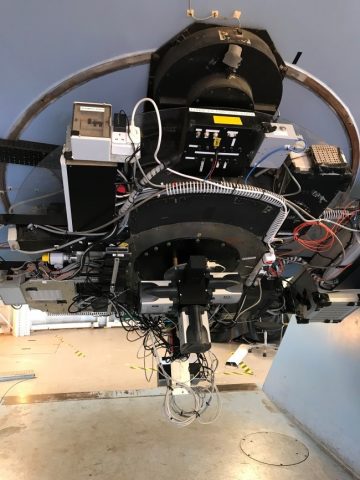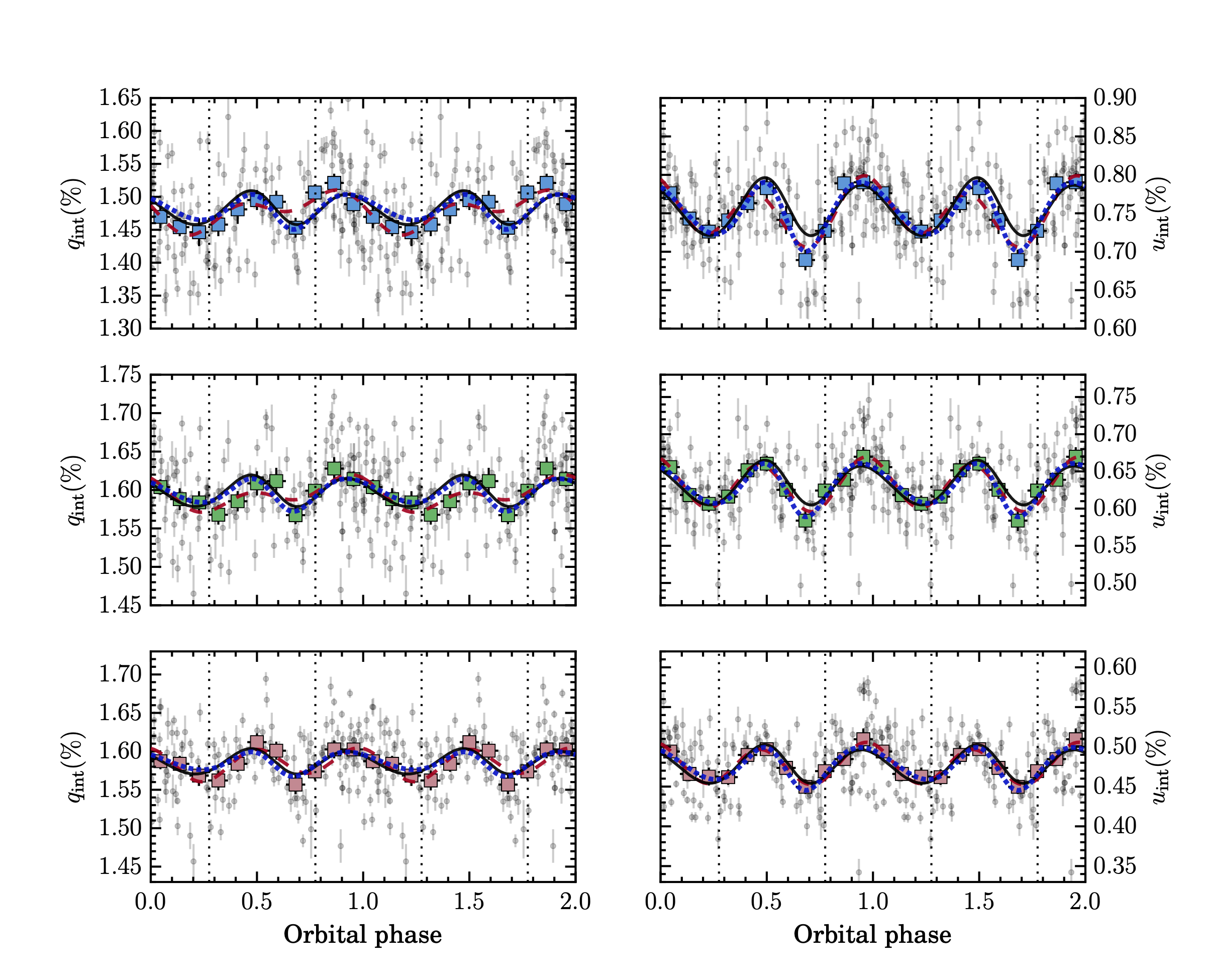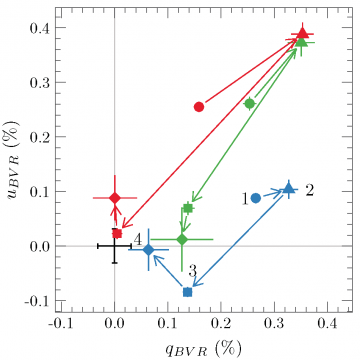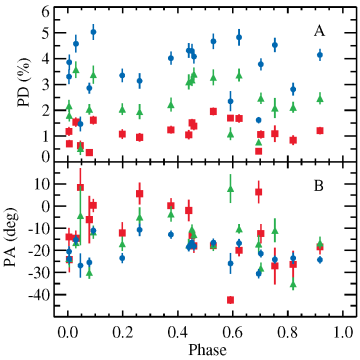Optical polarimetry
High-precision optical polarimetry is a powerful tool to study geometry and orientation of astrophysical objects. It can be used for determination of inclination and orientation of binary orbit and helps to locate various gaseous structures, such as streams, disks and jets. We possess a unique expertise in developing high-precision instruments for optical polarimetry. Two such instruments, DIPol-2 and DIPol-UF (Fig.1), have been built during the last decade in collaboration with the Institute of Solar Physics (Freiburg, Germany). Both polarimeters are currently employed for studying various polarization mechanisms, including polarization in exoplanets, binary systems and interstellar polarization with the accuracy up to 10-5 and better.

Fig. 1: New high-precision optical polarimeter DIPol-UF built at the University of Turku and installed at the Nordic Optical Telescope (Piirola et al. 2021).
With our previous instrument DIPol-2 installed at the T60 telescope at Haleakala observatory, we have observed high-mass gamma-ray binary LS I+61o 303 and for the first time detected variable, and synchronous with the orbital motion, linear polarization (Fig. 2, top). From analysis of polarization data with the model of Thomson scattering by a cloud that orbits the Be star, we obtained new constraints on orbital parameters, including a small eccentricity (e < 0.2) and periastron phase 0.6, which coincides with the peaks in the radio, X-ray, and TeV emission (Fig. 2, bottom).


Fig. 2: Top: Intrinsic normalized Stokes parameters q and u in B, V, R band (from top to bottom) and modelling curves. Bottom: Two possible geometries of the orbit of a compact object in LS I+61o 303 around Be star (yellow circle), which lies at the ellipse focus. The red dashed line is the major axis of the orbit. The black dots on the orbit are spaced by the phase interval Δφ=0.1. Phases of apoastron (0.12 or 0.09) and periastron (0.62 or 0.59) are shown by asterisks. From Kravtsov et al. (2020).
Using our high-precision polarimeters we started an observing program of Galactic black hole X-ray binaries. We observed V404 Cyg during its last outburst in 2015 with DIPol-2 and detected significant variations in the position angle of the intrinsic polarization in the R band from −30 deg to 0 deg during the outburst peak (Kosenkov et al. 2017). The observed wavelength dependence of the intrinsic polarization does not support non-thermal synchrotron emission from a jet as a plausible mechanism, but it is in better agreement with the combined effect of electron (Thomson) scattering and absorption in a flattened plasma envelope or outflow surrounding the illuminating source. Interestingly, the position angle of the intrinsic polarization is nearly parallel to the jet direction (i.e. perpendicular to the accretion disc plane). In agreement with the Japanize colleagues (Tanaka et al. 2016, Itoh et al. 2017), we do not confirm large intrinsic polarization claimed by Shahbaz et al. (2016) and Lipunov et al. (2016) .
Later, we have observed a new black hole transient MAXI J1820+070 during its outburst in 2018. We have measured intrinsic polarization of about 0.5% (rising to the red) in the rising hard state (Veledina et al. 2019) with the polarization angle (PA) of 25 deg coinciding with the position angle of the jet. Interestingly, during the soft state the intrinsic polarization dropped to <0.2% with highest PD in the blue (Kosenkov et al. 2020b) and changes the angle to -15 deg (see Fig. 3). High polarization was observed when also signatures of the winds are detected, arguing in favour of the wind as the scattering medium. We then observed the source in quiescence with DIPol-UF at the Nordic Optical Telescope and detected a much higher polarization with very blue spectrum and PD reaching 5% and PA=-20 deg (Fig. 4). Combining this with previous determinations of the relativistic jet orientation axis, which traces the black hole spin, and the inclination of the orbit, we determined a lower limit of 40 deg on the spin-orbit misalignment angle (see Fig.5). The misalignment has to originate from either the binary or black hole formation stage. If other x-ray binaries have similarly large misalignments, these would bias measurements of black hole masses and spins from x-ray observations. These results have been published in Science.

Fig.3: Normalized Stokes q and u parameters observed from MAXI J1820+070 during its outburst in 2018. Red, green, blue symbols decode data in the R, V, B bands. Circles and triangles correspond to the rising hard state, squares to the soft state, and diamonds to the decaying hard state. From Kosenkov et al. (2020b).

Fig. 4: Observed optical polarization properties of MAXI J1820+070 in quiescence. (A) Intrinsic polarization degree (PD) and (B) polarization angle (PA) are shown as a function of orbital phase. The intrinsic values were obtained from the observed ones by subtracting the foreground interstellar polarization, measured from nearby field stars. Blue circles, green triangles and red squares correspond to B, V , and R bands, respectively, with the error bars showing the 68% confidence level. Polarization is strongest in the B band and weakest in the R band, while the angle does not change substantially.
Fig. 5: Artist impression of the X-ray binary system MAXI J1820+070 containing a black hole (small black dot at the center of the gaseous disk) and a companion star (red). A narrow jet is directed along the black hole spin axis, which is strongly misaligned from the axis of the orbit. Video produced with Binsim (credit: R. Hynes).
Selected publications:
- Kravtsov V., Veledina A., Berdyugin A.V., Zdziarski A.A., Henson G.D., Piirola V., Sakanoi T., Kagitani M., Berdyugina S.V., Poutanen J.,
Peering into the tilted heart of Cyg X-1 with high-precision optical polarimetry,
2023, A&A, 678, A58 - Kravtsov V., Berdyugin A.V., Kosenkov I.A., Veledina A., Piirola V., Qadir Y.A., Berdyugina S.V., Sakanoi T., Kagitani M., Poutanen J.,
Optical polarization signatures of black hole X-ray binaries,
2022, MNRAS, 514, 2479-2487 - Poutanen J., Veledina A., Berdyugin A.V., Berdyugina S.V., Jermak H., Jonker P.G.,Kajava J.J.E., Kosenkov I.A., Kravtsov V., Piirola V., Shrestha M., Torres M.A.P., Tsygankov S.S.,
Black hole spin-orbit misalignment in X-ray binary MAXI J1820+070,
2022, Science, 375, 874-876 [arXiv] - Berdyugin A.V., Piirola V., Bagnulo S., Landstreet J.D., Berdyugina S.V.
Highly sensitive search for magnetic fields in white dwarfs using broad-band circular polarimetry,
2022, A&A, 657, A105 - Ilia Kosenkov, PhD thesis High-Precision Polarimetric, Broad-Band Spectroscopic and Temporal Studies of Black Hole X-ray Binaries, University of Turku, 2021
- Piirola V., Kosenkov I.A., Berdyugin A.V., Berdyugina S.V., Poutanen J.
DIPol-UF: Simultaneous three-color (BVR) polarimeter with EM CCDs,
2021, AJ, 161, 20 - Piirola V., Berdyugin A.V., Frisch P.C., Kagitani M., Sakanoi T., Berdyugina S.V., Cole A.A., Harlingten C., Hill K.
High-precision polarimetry of nearby stars (d < 50 pc). Mapping the interstellar dust and magnetic field inside the Local Bubble,
2020, A&A, 635, A46 - Berdyugin A.V., Piirola V., Poutanen J.,
Optical polarimetry: methods, instruments and calibration techniques,
2019, in ASSL 460, Astronomical Polarisation from the Infrared to Gamma Rays, eds. Mignani R., Shearer A., Slowikowska A., Zane S., Springer Nature, pp. 33-65 - Kosenkov I.A., Veledina A., Berdyugin A.V., Kravtsov V., Piirola V., Berdyugina S.V., Sakanoi T., Kagitani M., Poutanen J.,
Disc and wind in black hole X-ray binary MAXI J1820+070 observed through polarised light during its 2018 outburst,
2020, MNRAS Letters, 496, L96-L100 - Kravtsov V., Berdyugin A.V., Piirola V., Kosenkov I.A., Tsygankov S.S.,
Chernyakova M., Malyshev D., Sakanoi T., Kagitani M., Berdyugina S.V., Poutanen J.,
Orbital variability of the optical linear polarization of the γ-ray binary LS I +61° 303 and new constraints on the orbital parameters,
2020, A&A, 643, A170 - Veledina A., Berdyugin A.V., Kosenkov I.A., Kajava J.J.E., Tsygankov S.S., Piirola V., Berdyugina S.V., Sakanoi T., Kagitani M., Kravtsov V., Poutanen J.,
Evolving optical polarization of the black hole X-ray binary MAXI J1820+070,
2019, A&A, 623, A75 - Berdyugin A.V., Piirola V., Sakanoi T., Kagitani M., Yoneda M.,
High-precision broad-band linear polarimetry of early-type binaries. II. Variable, phase-locked polarization in triple Algol-type system λ Tauri,
2018, A&A, 611, A69, - Kosenkov I.A., Berdyugin A.V., Piirola V., Tsygankov S.S., Palle E., Miles-Paez P.A., Poutanen J.,
High-precision optical polarimetry of the accreting black hole V404 Cyg during the 2015 outburst,
2017, MNRAS, 468, 4362-4373 - Berdyugin A.V., Piirola V., Sadegi S., Tsygankov S.S., Sakanoi T., Kagitani M., Yoneda M., Okano S., Poutanen J.,
High-precision broad-band linear polarimetry of early-type binaries. I. Discovery of variable, phase-locked polarization in HD 48099,
2016, A&A, 591, A92, - Frish P.C., Berdyugin A.V., Piirola V., et al.
Charting the Interstellar Magnetic Field causing the Interstellar Boundary Explorer (IBEX) Ribbon of Energetic Neutral Atoms,
2015, ApJ, 814, 112